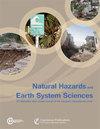InSAR(干涉合成孔径雷达)揭示了缓慢移动的尼斯Côte d’azur机场区域(法国)三十年的沿海沉降:对变形机制的见解
IF 4.7
2区 地球科学
Q1 GEOSCIENCES, MULTIDISCIPLINARY
引用次数: 0
摘要
摘要沿海地区可以拥有巨大的生物多样性,并拥有世界上很大一部分人口和关键的基础设施。然而,往往有脆弱的环境面临各种危险,如洪水、海岸侵蚀、土地盐碱化或污染、地震引起的陆地运动或人为过程。在本文中,我们研究了尼斯Côte d'Azur机场的稳定性,该机场建在瓦尔河三角洲(法国里维埃拉,法国)的填海土地上。自1979年该平台部分坍塌以来,这一基础设施以及机场跑道的持续下沉一直是一个令人担忧的问题。本文利用1992 - 2020年的ESA SAR(合成孔径雷达)图像完整档案,对机场沉降动态进行了综合监测。我们发现,最大向下运动速率已经从20世纪90年代的16 mm yr - 1放缓到今天的8 mm yr - 1。然而,沉积物压实作用仍在进行,不能排除持续蠕变的加速阶段导致部分平台的潜在破坏。我们的研究证明了远程监测平台对更好地了解沿海土地运动的重要性,这将最终有助于评估和减少相关危害。本文章由计算机程序翻译,如有差异,请以英文原文为准。
Three decades of coastal subsidence in the slow-moving Nice Côte d'Azur Airport area (France) revealed by InSAR (interferometric synthetic-aperture radar): insights into the deformation mechanism
Abstract. Coastal areas can be tremendously biodiverse and host a substantial part of the world's population and critical infrastructure. However, there are often fragile environments that face various hazards such as flooding, coastal erosion, land salinization or pollution, earthquake-induced land motion, or anthropogenic processes. In this article, we investigate the stability of the Nice Côte d'Azur Airport, which has been built on reclaimed land in the Var River delta (French Riviera, France). This infrastructure, as well as the ongoing subsidence of the airport runways, has been a permanent concern since the partial collapse of the platform in 1979. Here, we used the full archive of ESA SAR (synthetic-aperture radar) images from 1992 to 2020 to comprehensively monitor the dynamics of the airport subsidence. We found that the maximum downward motion rate has been slowing down from 16 mm yr−1 in the 1990s to 8 mm yr−1 today. However, sediment compaction is still active, and an acceleration phase of the continuous creep leading to a potential failure of a part of the platform cannot be excluded. Our study demonstrates the importance of remotely monitoring of the platform to better understand the motion of coastal land, which will ultimately help evaluate and reduce associated hazards.
求助全文
通过发布文献求助,成功后即可免费获取论文全文。
去求助
来源期刊
CiteScore
7.60
自引率
6.50%
发文量
192
审稿时长
3.8 months
期刊介绍:
Natural Hazards and Earth System Sciences (NHESS) is an interdisciplinary and international journal dedicated to the public discussion and open-access publication of high-quality studies and original research on natural hazards and their consequences. Embracing a holistic Earth system science approach, NHESS serves a wide and diverse community of research scientists, practitioners, and decision makers concerned with detection of natural hazards, monitoring and modelling, vulnerability and risk assessment, and the design and implementation of mitigation and adaptation strategies, including economical, societal, and educational aspects.

 求助内容:
求助内容: 应助结果提醒方式:
应助结果提醒方式:


